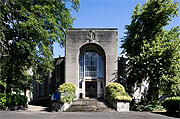Source: Reproduced with kind permission from the Touschek Family
Notable People
Bruno Touschek
-
Bruno Touschek and Sam Curran

-
Bruno Touschek 1952

Source: University of Glasgow
-
Bruno Touschek

Source: Reproduced with kind permission from the Touschek Family
-
Bruno Touschek's matriculation record page 1, 1947

Source: University of Glasgow
-
Bruno Touschek's matriculation record page 2, 1947

Source: University of Glasgow
Born 3 February 1921, Vienna, Austria.
Died 25 May 1978.
A world leading physicist who invented the storage ring most commonly used for storing high-energy elementary particles.
Connection to the University of Glasgow: Alumnus, Lecturer
GU Degree: PhD, 1949;
Discover more physicists on the University of Glasgow Story website
Achievements
The following achievement is associated with Bruno Touschek:
Inventing the storage ring for high-energy elementary particles
The storage ring is now the dominant facility for high energy elementary particle physics world-wide, whether in heavy-flavour studies at electron-positron facilities, or at the highest energies using proton - (anti) proton collisions at Fermilab (USA) or CERN Geneva) and electron-proton collisions (DESY, Hamburg).
Biography
Bruno Touschek (1921-1978) was a Glasgow graduate and lecturer in Natural Philosophy from 1949 to 1952 who invented the storage ring for high-energy elementary particles.
Born in Vienna in 1921 his early academic career was blighted by anti-Semitism and he was forced to leave the University of Vienna in 1940 because his mother was Jewish. He was able to continue his studies at Hamburg, where he was unknown, and there he worked with Rolf Wideroe on the development of the Betatron, the first circular accelerator for electrons. They were already discussing the possibility of colliding stored electrons and positrons head-on. His work was disrupted by his arrest by the Gestapo in 1945 and subsequent forced march to Kiel. He survived and graduated from Gottingen in 1946.
Touschek became a DSIR fellow at the University in 1947 and began research for a PhD which was published in 1949. He then became a lecturer in Natural Philosophy and he continued to develop his work on accelerators. He left the University in 1952 and became a researcher at the National laboratories of the Istituto Nazionale di Fisica Nucleare in Frascati and a lecturer at the University of Rome-La Sapienza. He died in 1978.

